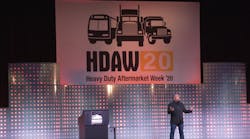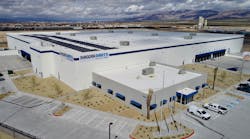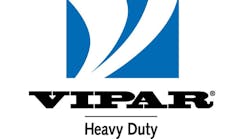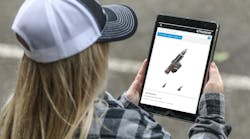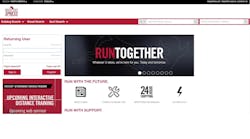Let's face it. In many markets in America, the traffic is so bad that you almost shrug your shoulders and say “you can't get there from here.”
If enough parts customers feel that way, what does that say about your ability to sell parts? Does this present a problem or an opportunity?
Clearly the company that makes it easier for the customer to buy, all other things being equal, has the advantage when it comes to making the sale.
So when traffic in most markets is only getting worse, why would a successful trailer dealer build a new shop far away from a major market?
Three simple reasons: It is able to reach out to customers, customers are relocating near the company's location, and there is a huge savings in real estate costs.
Such is the case with Utility Trailer Sales of Central California, a multi-location trailer dealer headquartered in Lathrop, California. Lathrop is 60 miles from one of the largest population centers in America, the San Francisco Bay Area. Viewed another way, Lathrop is an hour away from the Bay Area in theory and an eternity away in traffic.
But with more and more of its customers leaving the congestion of the Bay Area and moving to California's central valley, management at Utility Trailer Sales of Central California was confident that Lathrop was a good location after outgrowing its 10,000-sq-ft shop in nearby Modesto.
“As major cities become increasingly crowded, it becomes more and more difficult for trucks to get around,” says Mike Sutherland, president. “Major customers are responding to that by moving out to places such as Lathrop. That has certainly happened in our market. Safeway has built its distribution center in Tracy (about 10 miles from the new Utility Trailer Sales of Central California location). They had been in Richmond (a suburb of Oakland). Costco has a warehouse in the area. Given the traffic and the economics, we believe other companies will follow.”
Probably so. But what about the major companies that remain? How can a trailer dealer remotely serve a major market?
“Fleets bring major wrecks to us for repair,” Sutherland says. “But we can't count on them to come to us to buy parts. That's why we use mobile parts trucks to retain their business.”
Getting around
The idea of mobile parts trucks to serve fleets and small repair shops is nothing new, but it becomes increasingly important for a company such as Utility Trailer Sales of Central California.
Actually the delivery equipment that the company uses is not so much trucks as it is trailers. Utility Trailer Sales of Central California has three rigs in Lathrop and another three based at its Fresno shop 125 miles to the southeast — ¾-ton diesel pickups that pull 14-ft gooseneck trailers.
“We like the idea of using trailers to deliver parts,” Sutherland says. “Trailers are easy to load and unload and secure. And if a truck breaks down, we can still use our trailers to serve our customers.”
The trucks are all Ford F-250 models equipped with Powerstroke diesels. In addition, three Ford Ranger pickups are used for making sales calls and to deliver parts if necessary.
“Our managers call on key accounts, and they also travel with our vendors,” Sutherland says. “They make a lot of presentations to customers, and our route drivers make sales calls, too.”
Utility Trailer Sales of Central California keeps the trailers moving.
“We load them up with flooring, toolboxes, whatever,” Sutherland says. “We also use them to help distribute product between our stores. And because we are a Sumitomo tire dealer, they deliver a lot of tires.”
The company covers an area stretching about 175 north-to-south and roughly 200 miles east-to-west (from the Pacific to the Sierra Nevada Mountains).
“Of course we ship parts wherever they are needed,” Sutherland says. “We routinely ship to Hawaii.”
Staffing the department
Utility Trailer Sales of Central California is a full-service dealership, offering new and used trailer sales, parts sales, and service. Roughly half of the employees are involved in parts sales.
“We have a parts manager, lead counterman, sales coordinators, route sales, helpers, and shipping and receiving personnel,” Sutherland says. The company also has a telemarketer. He has a variety of responsibilities, which include qualifying the company's direct mail list.
The telemarketer is based at Utility Trailer Sales of Central California in Fresno. When the company first began using a telemarketer, about 95% of his calls were outbound. Now he handles a mix of incoming and outgoing calls, including the coordination of parts deliveries.
Promoting parts sales
Utility Trailer Sales of Central California also uses direct mail to promote its sale of aftermarket parts. The company produces an 8-12-page mailer about six to nine times per year. More than 3,000 copies are printed. They are mailed to customers and are given out at the parts counter.
The dealer also takes advantage of some of the efforts that Utility Trailer Manufacturing has made to help dealers sell parts.
“About 50-80% of our incoming calls are for parts,” Sutherland says. “Customers are calling to check our prices and availability. Utility Trailer Manufacturing has done a lot of online work to help automate this process. Customers can find out a lot about the parts that go into their trailers just by plugging in the serial numbers.”
While Sutherland admires what Utility Trailer Manufacturing has accomplished to make it easier for customers to buy parts, he does not plan to duplicate those efforts on a local level.
“Internet access would be great for our customers if we didn't call on them so often,” Sutherland says. “But we call on a lot of our customers daily. Many of our customers don't stock parts. They rely on the $1 million that we have in inventory at this location and the $2 million in parts that we stock companywide. When you have that kind of relationship with customers, you have to work closely with them.”
Larger quarters
Utility Trailer Sales of Central California moved into its new shop three years ago, enough time for the company to prove the design and replicate it at its other store in Fresno.
“We should be able to apply what we have learned here,” Sutherland says. “By watching what Utility Trailer Manufacturing has done, you can learn a lot about what it takes to be successful. They reinvest their earnings in their business. Look at the plants they have built in Utah, Paragould, and Glade Springs. This is a company that is in it for the long term. They have invested heavily in new plants and equipment, and we are following their lead. Our thinking is to dominate this part of northern California. We have sold a lot of trailers over the years, and we have been plowing the results of those sales back into this company. Sure, others can come in and try to take business from us. But by continuing to invest in facilities and personnel, we make it very difficult for them to do it.”
The 45,000-sq-ft facility was built on a 26-acre site, 14 acres of which is paved. The site is strategically located between two Interstate exits on a two-way service road. The significance: easy on, easy off, regardless of the direction the customer is traveling. In addition to being convenient to customers who are moving close by, the dealership also is near Kenworth and Freightliner dealerships. The result may not be one-stop shopping, but at least fleets can get tractor and trailer sales, parts, and service in the same general area.
“We traveled the country with our ‘20 group’ getting ideas about how this location should be designed,” Sutherland says.
One of the design considerations was the convenience of parts customers. The building is set back 200 feet from the road, making it easier for parts customers to pull in with their tractor and trailer without being affected by other customers who have driven their big rigs in for service.
Other considerations
The convenience for parts customers was but one of a series of design goals Utility Trailer Sales of Central California management had in mind when designing the new location. Others included:
-
Safety
-
Efficiency
-
The ease of getting 53-ft trailers in and out of the facility.
-
Upgraded lighting.
-
Room to expand.
-
State of the art phone and computer systems.
-
Offices with windows.
-
Nice environment inside and out without being excessive.
“The facility we had was at the end of its life,” Sutherland says. “It had served us well for a long time, but it was time for something new.”
Because of its size, the new facility enabled the company to consolidate multiple locations. The main shop had been in Modesto, with smaller shops in Hayward and Woodland.
The building was constructed as a single story.
“We thought about having a second floor for parts storage, but the idea just seems to be either a potential safety hazard or space that we would not utilize very well,” Sutherland says.
The Utility Trailer Sales of Central California facility is the result of an extensive period of dreaming, planning, and negotiating.
The company bought the site in 1999 and then began drawing up plans for the building. But management put the plans on hold when signs began to appear that the trailer market was getting soft.
It was not until 2004 that Utility Trailer Sales of Central California moved into the new building — after five years, one economic downturn, and a lot of planning.
“We had not built a new building before,” Sutherland says. “We wanted to make sure we got it right.”
Utility Trailer Sales of Central California hired an architect, but the company also consulted HVAC contractors, plumbers, and other local companies that had experience maintaining the systems that Utility Trailer Sales of Central California was going to need.
Saving $1 million
Even with the planning Utility Trailer Sales of Central California put into the building, the company wound up redesigning the way the building was positioned on the property.
“It's always a lot easier to change a building on paper than it is to make changes after it is built,” Sutherland says.
By rotating the building 90 degrees from the way it originally was to be placed on the site, Utility Trailer Sales of Central California was able to save approximately $1 million in site preparation, Sutherland says.
Repositioning the building, however, was not easy — even on paper. That's because the City of Lathrop did not want the shop doors facing the street.
“We had to show the city that from an aesthetic standpoint, it really did not make any difference which direction the doors faced. We were going to build a nice building either way. But while it may not have made much difference aesthetically, saving that much money in site preparation made a big difference to us.”
Saving even more
Reorienting the building may have saved the company money, but the selection of the site was even more of a cost savings — at least compared with one of the options Utility Trailer Sales of Central California had when deciding how to serve the Bay Area and the central valley.
“Trying to build closer in was out of the question,” Sutherland says. “I know of someone who bought two acres and spent far more than I did for 26 acres and this building.”
Another key is that Lathrop is just south of what could be considered one of the key crossroads in America — Interstate 80, which connects San Francisco and New York, and Interstate 5, running from Canada to Mexico via Seattle and San Diego.
“We appreciate those customers,” Sutherland says. “But we can't base our business on people who are passing through the area. It's been important for us to build around a customer base.”
Even when it means driving parts through traffic so that the customer does not have to.

